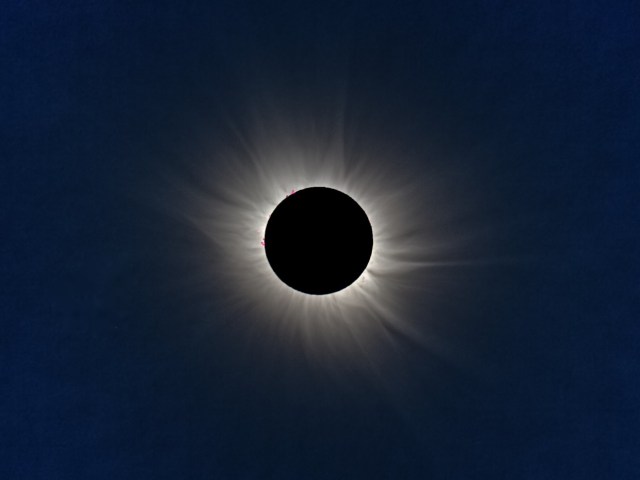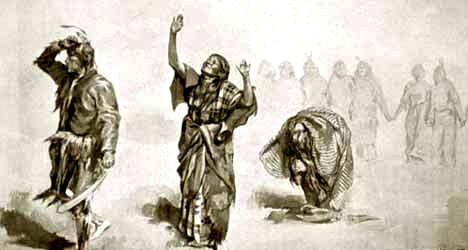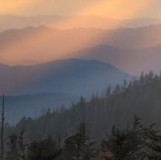“It’s so beautiful.” My voice was uncontrollably shaking and tears were welling up in my eyes. Like Jodie Foster at the end of Contact.

I took this photograph about ninety seconds before totality. It’s a 180-degree panorama, looking south, with the east on the left edge and the darkening west on the right.
From atop a sagebrush bluff in eastern Oregon, we felt the day cool and the bright yellow landscape fade into muted tones. Ten minutes before totality, in a half-light like some strange Instagram filter, a Brewer’s Sparrow started singing. Three minutes before, Venus appeared almost directly overhead and the horizon and sky in the west sank into a deep velvety midnight blue, as if blackness was pouring down from the heavens. Distant smoke from a fire on the southern horizon lit up like a sunset. Two minutes to go, with darkness from the west spreading, threatening to envelope us, the crowd began to exclaim, “It’s coming!” and “Oh my God!” And, then, suddenly, we looked up, and there it was– floating in cool peaceful stillness, a perfect black disc surrounded by a silky silver corona. In its serene beauty, it seemed to be looking at us. Benevolently. It felt much closer to me than the sun normally feels, perhaps just a few thousand feet up. It was real; everything else was surreal.

I elected to avoid fussing with my camera during totality, but I searched the internet for the image that came the closest to what I saw. Nothing comes close to what it’s like in real life, but this one from a different eclipse in Norway came the closest.
Our time in its presence lasted just shy of two minutes and eight seconds, but the memory is seared in my mind. I still cannot explain why it felt so meaningful. It certainly sent a message that the universe was tightly held together, that everything was in order, that at 10:23:37.6 in the morning, on schedule, it came to us. It was beautiful– yes, possibly the most beautiful thing I’ve ever seen, and certainly the most unique– but it was just physics. Yet it felt so emotionally fulfilling.
Through binoculars we saw little red solar prominences on the perimeter of the black disc, and the little hot dot of Mercury just off to the left. As the corona blinked and turned into a diamond ring, we watched diffuse “shadow bands” dance on a white sheet I had draped over a large sage. The great tranquil eye was turning its gaze eastward. I thought of friends in Carbondale and Charleston and the joy coming their way. Eclipses should be longer. There should be more of them. If I think about this experience on my deathbed, I’ll die with a smile on my face.
Here is a seven-minute video, which captures our view southwest of the valley before us (the town of Unity, Oregon is just left of center), and the audio of our reactions.
Key moments:
2:00 The shadow is coming
2:30 It’s coming
3:20 Totality!
5:40 Sunlight returns; shadow bands are called out
Total eclipses have a long history of inspiring visions that changed the course of human events. In North America, Wovoka’s epiphany from a similar sage-covered hilltop in northern Nevada during the January 1, 1889 eclipse had dramatic ramifications.
From Suggestions for Observing the Total Eclipse of the Sun on January 1, 1889, published by the University of California:
What is first noticed is the change which takes place in the color of the surrounding landscape, which begins to wear a ruddy aspect. This grows more and more pronounced, and gives to the adjacent country that weird effect which lends so much to the impressiveness of a total eclipse. The color changes because the earth’s atmosphere absorbs a larger proportion of the blue rays than of the red…
The color of the light becomes more and more lurid up to the moment when the sun has nearly disappeared. If the spectator is upon the top of a high mountain, he can then begin to see the moon’s shadow rushing towards him at the rate of about a mile in a second. Just as the shadow reaches him there is a sudden increase of darkness; the brighter stars begin to shine in the dark lurid sky, the thin crescent of the sun breaks up into small points or dots of light, which suddenly disappear, and the moon itself, an intensely black ball, appears to hang isolated in the heavens.
An instant afterward the sun’s corona is seen surrounding the black disc of the moon with a soft effulgence quite different from any other light known to us.
Around 2pm on that day, as the land and sky turned dark, stars appeared, and the corona blinked on like a benevolent eye, Wovoka of the Northern Paiute saw more than all that. For two minutes of totality, he saw a new earth, filled with the resurrection of the dead,

Paiute Ghost Dance, 1890
living in peace as in times of old, in a land teeming with deer and buffalo. His vision spread throughout the West, from reservation to reservation. Tribes sent emissaries. The vision grew. Jesus will return to save his people, the American Indians. (Does He not look like one? Did not the whites kill him the first time he came?) Living in His presence, there will be no hunger, no disease, and no death; no tears, pain, or mourning. The whites will sink into the soil. All will be made new. This will come to pass if the people perform the Ghost Dance.
The US responded to the dancing Natives. In less than two years, to stop the dancing, Sitting Bull was assassinated and hundreds of elders, women, and children were slaughtered at the Wounded Knee Massacre.
For more information about the significance of eclipses to various Native ethnic groups, see this recent collection just compiled by the National Museum of American Indians.
Celestial events put human troubles in perspective. We live in a different time than Wovoka, when the laws of nature exemplified by the eclipse boomerang on us, in the form of CO2 levels in the atmosphere. Humans have no power to alter the course of the earth and moon, but, unfortunately, we can screw up the planet’s climate, which follows certain natural rules. As we walked down the bluff after the eclipse, surrounded by former NASA scientists and others intimately familiar with climate change, the rebounding desert temperature was a quick reminder. It is the problem that supersedes all others. Were there visions of peace and resolution to this problem? And will the forces arrayed against this dance succeed?
Coming Total Eclipses
Here is a short summary:
July 2, 2019 – northern Chile and Argentina, with 2 minutes of totality in Chile
December 14, 2020 – southern Chile and Argentina, with 2:10 of totality
April 20, 2023 – Eastern Timor and western Australia, with 1 minute of totality in Australia
April 8, 2024 – Mazatlan to Newfoundland (sometimes described as Texas to New England), with 4 1/2 minutes of totality in Mexico
August 12, 2026 – Iceland to Spain, with 2 minutes of totality
August 2, 2027 – a massive eclipse from Gibraltar, Spain and Morocco across northern Africa and the Middle East, including Mecca, with over 6 minutes of totality near Luxor, Egypt.


A few additional thoughts– There are a lot of metaphors going on during a total eclipse. Obviously, the sun as god, life-giving (OMG even 1% sun gives a ton of light and warmth) and yet unapproachable, dangerous to look at. During totality, that which was formerly dangerous is suddenly looking at you, like a beautiful peaceful eye, or perhaps a window in the sky, connecting the earth and heavens. Like a perfect parent, totality arrives with 100% reliability, and is available to all in its path, and thus perfectly accessible to all underneath it. The switch from dangerous-to-look-at to the-most-peaceful-and-beautiful-thing-you’ve-ever-seen is instant and dramatic, stunning and powerful.